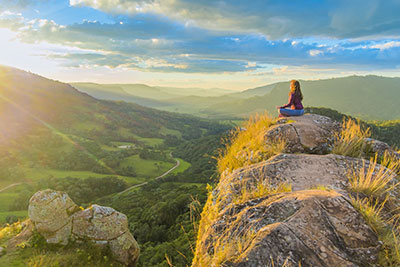 Spending time in nature is an approach that has demonstrated strong anxiolytic effects. There has been a considerable amount of research showing that nature benefits psychological health and wellbeing, including studies that found spending time in natural spaces is an effective intervention for the management of anxiety symptoms.
Spending time in nature is an approach that has demonstrated strong anxiolytic effects. There has been a considerable amount of research showing that nature benefits psychological health and wellbeing, including studies that found spending time in natural spaces is an effective intervention for the management of anxiety symptoms.
Experiences in nature have been shown to enhance vitality, happiness, self-esteem, and reduce stress. Studies have noted a link between nature and lower levels of anxiety and its precursors.
Feeling connected to nature has been linked with lower overall anxiety. For example, a 2014 study found that individuals with higher levels of connection to nature had significantly lower levels of overall state and trait cognitive anxiety. In particular, the researchers found that physical familiarity with nature provided experiential connection which was most significantly linked to lower anxiety.
A 2017 study compared levels of anxiety for regular indoor exercisers against regular outdoor exercisers and also found that physical familiarity with nature was most strongly linked to lower anxiety scores. The researchers noted that exercising regularly outdoors predicted lower anxiety levels whereas exercising indoors predicted higher anxiety. This study is also important because some people experiencing panic attacks when exercising indoors. For them, exercising outside may help them avoid that scenario.
Of course, in some contexts spending time in nature may not be possible. An example would be a therapeutic setting with no access to any nature stimuli. In these instances, nature-based guided imagery can overcome the limitation of access to nature and strengthen the impact of guided imagery.
A 2019 study used nature-based guided imagery to improve the symptoms of anxiety. The study included 48 adults who took part in 10-minute guided imagery sessions led by an audio recording. During the sessions, participants were asked to mentally transport themselves to either a nature scene or an urban scene of their own choosing. To make this imagined experience more real, participants were asked to:
- Visualize the colors and shapes around them
- Engage other senses, such as smell and touch
- Picture themselves moving and interacting within the scene
Before and after the guided imagery sessions, participants filled out questionnaires that measured their anxiety levels. Both nature-based and urban-based imagery reduced their anxiety, but the effect was more pronounced when nature imagery was used.
The most common visualization used in guided imagery involves a tropical beach, warm sun and soothing sounds of the ocean. However, if you find that some other imagined scene is better for you, such as sitting under a starry sky on a warm night, by all means, make use of that setting.
The type of scene is not important; what matters is that you imagine every sight, sound and smell and transport yourself to that place. Guided imagery constructs an immersed state of mind throughout the entire body by visualizing all five senses. With guided imagery, you are using the sole power of your own imagination.
Dr. Randi Fredricks, Ph.D.
Author Bio
Dr. Randi Fredricks is a leading expert in the field of mental health counseling and psychotherapy, with over three decades of experience in both research and practice. She holds a PhD from The Institute of Transpersonal Psychology and has published ground-breaking research on communication, mental health, and complementary and alternative medicine. Dr. Fredricks is a best-selling author of books on the treatment of mental health conditions with complementary and alternative medicine. Her work has been featured in leading academic journals and is recognized worldwide. She currently is actively involved in developing innovative solutions for treating mental health. To learn more about Dr. Fredricks’ work, visit her website: https://drrandifredricks.com
References
Bratman NG, Hamilton JP, Hahn KS, Daily GC, Gross JJ. (2015). Nature experience reduces rumination and subgenual prefrontal cortex activation. PNAS, 28, 8567-8572.
Carrus G, Scopelliti M, Panno A, Lafortezza R, Colangelo G, Pirchio S, et al. (2017). A different way to stay in touch with ‘Urban Nature’: the perceived restorative qualities of botanical gardens. Front. Psychol, 8, 914.
Martyn P, Brymer E. (2014). The relationship between nature relatedness and anxiety. J. Health Psychol, 21, 1436–1445. Martyn P, Brymer E. (2014). The relationship between nature relatedness and anxiety. J. Health Psychol, 21, 1436–1445.
Lawton E, Brymer E, Clough P, Denovan A. (2017). The relationship between the physical activity environment, nature relatedness, anxiety and the psychological wellbeing benefits of regular exercisers. Front. Psychol, 8, 1058.
Nguyen J, Brymer E. (2018). Nature-Based Guided Imagery as an Intervention for State Anxiety. Front Psychol, 9, 1858.

